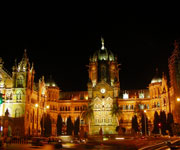Chhatrapati Shivaji Terminus is an outstanding example of late 19th-century railway architecture in the British Commonwealth, characterized by Victorian Gothic Revival and traditional Indian features, as well as its advanced structural and technical solutions. It became a symbol for Bombay (now Mumbai) as a major mercantile port city on the Indian subcontinent within the British Commonwealth.
Continent: Asia
Country: India
Category: Cultural
Criterion: (II)(IV)
Date of Inscription: 2004
Chhatrapati Shivaji Terminus
The Chhatrapati Shivaji Terminus is situated is associated with the origins of Mumbai as a city. Bombay Island had formed a coastal outpost of the Hindu in western India, but was not used for commerce. It was first passed to the Portuguese and then, in 1661, to the British. In 1667, the island was transferred to the East India Company, who was principally responsible for its commercial development. Merchants settled here from elsewhere, and the shipbuilding industry and the cotton trade prospered.
The town flourished, especially after the building of railway connections with the inland and the opening of the Suez Canal in 1869. With the development of trade, the Governor of Bombay planned a series of works aiming at the construction of a more representative city. This involved land reclamation and the construction of a magnificent ensemble of High Victorian public buildings along the seafront. The Victoria Terminus, the most impressive of these buildings, was named after Queen Victoria, Empress of India, on whose Golden Jubilee it was formally opened in 1887.
 |
| Chhatrapati Shivaji Terminus India |
Browse Gallery Plus UNESCO Storyline
The terminus, now called Chhatrapati Shivaji Terminus, was designed by the British architect Frederick William Stevens (1848-1900). Work began in 1878 and was completed 10 years later. Originally intended only to house the main station and the administrative offices of the Great Indian Peninsula Railway, a number of ancillary buildings have been added subsequently, all designed to harmonize with the main structure. A new station to handle main-line traffic was erected in 1929. The original building is still in use for suburban traffic and is used by over 3 million commuters daily. It is also the administrative headquarters of the Central Railway
The terminus is one of the first and the best products of use of industrial revolution technology merged with the Gothic Revival style, which was based on late medieval Italian models. This style was acceptable to both European and Indian taste, as it is compatible in its use of colour and ornamentation with the Mughal and Hindu architecture of the subcontinent. The skyline, turrets, pointed arches and eccentric ground plan are close to traditional Indian palace architecture.
The centrally domed office structure has a deep platform connected to a train shed, and its outline provides the skeleton plan for building. The terminus dome of dovetailed ribs, built without centering (framing for an arch), was a novel achievement of the era. The interior of the building was conceived as a series of large rooms with high ceilings. It is a utilitarian building and has had various changes required by the users, not always sympathetic. Its C-shaped plan is symmetrical on an east-west axis. All the sides of the building are given equal value in the design. It is crowned by a high central dome, which acts as the focal point.
The dome is an octagonal ribbed structure with a colossal female figure symbolizing Progress, holding a torch pointing upwards in her right hand and a spoked wheel in her left. The side wings enclose the courtyard, which opens on to the street. The wings are anchored by monumental turrets at each of their four corners, which balance and frame the central dome.
The facades present the appearance of well-proportioned rows of windows and arches. The ornamentation in the form of statuary, bas-reliefs and friezes is exuberant yet well controlled. The columns of the entrance gates are crowned by figures of a lion (representing Great Britain) and a tiger (representing India).
The main structure is built from a judicious blend of India sandstone and limestone, while high-quality Italian marble was used for the key decorative elements. The main interiors are also lavishly decorated: the ground floor of the North Wing, known as the Star Chamber, which is still the booking office, is embellished with Italian marble and polished Indian blue stone. The stone arches are covered with carved foliage and grotesques.
Browse All UNESCO World Heritage Sites in
India. The original UNESCO inscription
Here!!!




